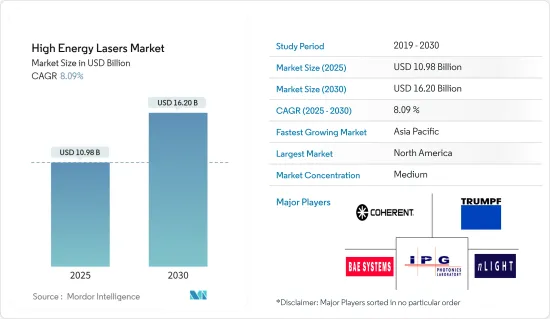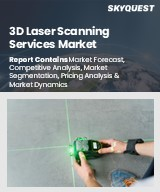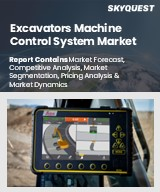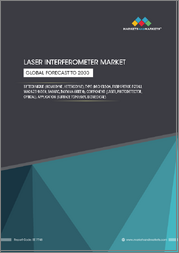
|
시장보고서
상품코드
1687945
고에너지 레이저 시장 : 시장 점유율 분석, 산업 동향 및 통계, 성장 예측(2025-2030년)High Energy Lasers - Market Share Analysis, Industry Trends & Statistics, Growth Forecasts (2025 - 2030) |
||||||
고에너지 레이저 시장 규모는 2025년에 109억 8,000만 달러로 추정되고, 예측 기간 2025년부터 2030년까지 CAGR 8.09%로 성장할 전망이며, 2030년에는 162억 달러에 달할 것으로 예측되고 있습니다.

이 업계는 COVID-19의 대유행에 의해 타격을 받은 업계의 하나입니다. 기계의 재고 수요가 감소했기 때문에 하이엔드 레이저 수요도 2020년에 감소했습니다. 시장은 감속과 중국 수요 증가 후 결국 회복하기 시작했습니다.
주요 하이라이트
- 레이저는 미사일에 효과적임이 입증되었으며 현재 방위의 최일선으로 사용되고 있습니다. 방위 예산과 연구 보조금 증가로 세계 군이 고에너지 레이저 기반 장비를 채택하여 연구 개발에 많은 투자를 하고 있습니다.
- 고에너지 레이저는 제조, 통신, 방위에 대한 용도가 진행되어 현대사회에서 중요한 역할을 하고 있습니다. 방위 예산과 연구 보조금 증가에 따라 세계 군이 고에너지 레이저를 기반으로 한 기기를 채용하여 연구 개발에 많은 투자를 실시했습니다. 예를 들어, 미국 육군은 2021년 5월 근거리 방공용 레이저 무기의 프로토타입 테스트를 시작했습니다. 이 무기는 스트라이커 A1 차량에 장착된 50킬로와트의 고에너지 레이저로 공중 위협의 위치를 확인, 잠금, 추적 및 파괴할 수 있습니다.
- 이 기술의 연구 개발 및 용도는 방위 산업이 큰 점유율을 차지합니다. 주요 지출국은 자국의 군 및 작전의 일부로 이 기술을 개발하고 도입하는 데 열심입니다. SIPRI에 따르면 세계 군사비 총액은 2021년 실질 기준으로 0.7% 증가하여 2조 1,000억 달러에 달했습니다. 세계 군사비에 관한 새로운 데이터에 따르면 2021년 5대 지출국은 미국, 중국, 인도, 영국, 러시아에서 총 지출의 62%를 차지했습니다. 이러한 개발은 신기술과 현대화의 길을 열어야 합니다.
- 방위 분야에서의 드론의 보급에 따라 드론을 추적 및 파괴할 수 있는 솔루션에 대한 수요가 높아지고 있습니다. 예를 들어 2021년 3월 유럽 미사일 제조업체인 MBDA와 프랑스 CILAS는 전자전과 인텔리전스 전문가인 SIGN4L과 협력하여 무인 항공기를 파괴하는 고에너지 레이저 무기 시스템의 공동 개발 기회를 모색하기로 합의했습니다. 이러한 개발은 향후 수년간 더 증가할 것으로 예상됩니다.
- 미사일 방위 시스템의 일부로서 고에너지 레이저의 용도가 증가할 것으로 예상되며, 주요 방위 지출자들은 점차 이러한 솔루션을 채택하고 이러한 솔루션의 개발에 관심을 보이고 있습니다. 예를 들어, 2021년 3월, 이스라엘 국방부는 항공 및 미사일 방위 레이저에 대한 미국의 자금과 전문 지식을 찾는 관심을 보였습니다. 이스라엘의 현재 프로토타입은 거의 100킬로와트의 출력 빔을 달성하는 반면, 미국은 순항 미사일을 죽일 수 있는 300킬로와트 무기를 연구하고 있습니다.
- 연구자들에게 가장 어려운 과제는 여러 물체를 동시에 추적하면서 목표를 부분적으로 손상시키거나 격파하기에 충분한 높은 수준에 도달할 수 있는 레이저를 만드는 것입니다. 먼지와 습기와 같은 난기류 속에서 레이저는 효율적으로 전파되어야 하고 대상에 정확하게 초점을 맞추어야 합니다. 시스템은 목표 움직임, 플랫폼 움직임, 날씨 및 환경 조건에 의해 야기되는 빔 왜곡을 고려해야 합니다.
고에너지 레이저 시장 동향
해군에서의 레이저 무기 시스템 수요 증가 및 비치사적 억제력의 성장
- 미사일과 무인 항공기와 같은 공중으로부터의 위협에 대항하기 위해 해군의 레이저 무기 시스템에 대한 수요는 세계적으로 빠르게 증가하고 있습니다. 미사일에 대한 방위의 제일선으로서 레이저가 사용되고 있는 이유는 그 효과가 증명되고 있기 때문입니다. 예를 들어, 비행 IIA DDG 아레이 버크 구축함에는 2021년 록히드 마틴의 헬리오스(High Energy Laser with Integrated Optical-dazzler and Surveillance)가 영구적으로 탑재될 예정입니다. 레이저는 미국 해군에 의해 공식적으로 이지스 전투 시스템에 통합되었습니다.
- 이 외에도 레이저 기반 무기는 해군 함정에 탑재하여 무인기를 무력화하는 테스트가 진행되고 있습니다. 예를 들어, USS 포틀랜드는 COVID-19의 새로운 고에너지 레이저 무기 시스템을 테스트하는 동안 승무원이 없는 공중 차량을 무효화하는 데 성공했습니다. 이 시스템은 노스롭 그라만사가 개발한 것으로, 미국 해군의 P-8A 포세이돈 초계기가 무기급의 레이저를 조사한 중국 구축함의 사건 후에 테스트가 실시되었습니다.
- 미국뿐만 아니라 다양한 국가들이 위협을 억제하고 무력화하는 해군 능력의 확대를 목표로 하고 있습니다. 중국은 이 분야에서 미국과 패권을 다투는 국가 중 하나입니다. 중국 인민 해방군 해군(PLA 해군)은 미국 해군의 레이저 무기 시스템(LaWS)과 닮은 전술 레이저 시스템을 테스트했습니다.
- 해군의 속국은 미사일이나 다른 공중으로부터의 위협에 노출되기 쉽기 때문에 방위 부문은 점점 그러한 위협으로부터 보호할 수 있는 기술을 개발하고 도입하고 있습니다. 2021년 3월에는 함재 레이저 무기가 핀 포인트의 정확성 달성에 가까워지고 있다고 발표했습니다.
아시아태평양이 가장 높은 성장을 이룹니다.
- 아시아태평양은 중국, 인도, 일본 등 주요 국가가 견인하는 시장의 성장에 따라 다양한 분야에서 고에너지 레이저를 채용하는 주요 지역이 되고 있습니다. 미국과 중국의 긴장, 국경을 넘은 분쟁, 원자력에 대한 주목은 인도와 같은 지역의 여러 나라의 방위 및 군사 시스템에서 고에너지 레이저를 더욱 촉진하고 있습니다.
- 인도의 육군과 공군을 위한 전술 고에너지 레이저 시스템의 일부로서, 국가는 국방부의 기술 전망과 능력 로드맵의 일부로서 고에너지 레이저를 군에 채택하고 장려하고 있습니다.
- 인도 국방 연구개발기구는 고에너지 레이저를 포함한 지향성 에너지 무기에 관한 국가 프로그램을 형성할 계획을 발표했습니다. DRDO는 화학산소-요오드 레이저와 고출력 파이버 레이저에 종사하고 있으며, 국방부에서 2021-2022년 예산으로 1억 달러의 예산을 획득하여 고출력 레이저 무기 생산을 목표로 했습니다. 고에너지 레이저에 대한 이러한 지출은 이 나라의 성장에 긍정적인 영향을 미칠 것으로 예상됩니다.
- SIPRI에 따르면 세계 2위 소비국인 중국은 2021년 군사비를 4.7% 증가한 2,930억 달러로 추정하고 있습니다. 중국은 27년 연속 군사비를 늘리고 있습니다. 2021년부터 2025년까지의 14차 5개년 계획은 2021년 중국 예산에서 처음으로 실시되었습니다. 새로운 개념 무기의 일환으로 중국은 방위 시스템에 고에너지 레이저를 도입할 예정입니다. 군사비와 HEL의 통합에 대한 국가의 기울기는 조사된 시장의 긍정적인 성장을 보여줍니다.
- 군사적 우위성의 관점에서 우주공간을 통제하는 것에 중점을 두고 있으며, 조사시장은 중국이 연구개발에 정부자금을 투입해 가는 기술진보로부터 이익을 얻을 것으로 기대되고 있습니다.
고에너지 레이저 산업 개요
고에너지 레이저 시장은 적당한 경쟁이며 다수의 주요 기업으로 구성되어 있습니다. 특히 북미와 같은 신흥 경제 국가에서는 많은 대기업들이 시장 점유율로 시장 전체의 상당한 점유율을 유지하고 있습니다. 대기업은 항상 새로운 기술 혁신을 수행하고 연구 개발에 투자하고 있습니다. 또한 이 기업들은 전략적 협업 이니셔티브를 활용하여 시장 점유율을 확대하고 수익성을 높이고 있습니다.
- 2022년 9월-The Laser Cutting Company(TLCC)는 Trumpf 솔루션인 EdgeLine Bevel이 장착된 고에너지 Trumpf TruLaser 5040 파이버 플랫베드 레이저 커터를 출시했습니다.
- 2022년 9월-레이저 절단 및 용접 제조 솔루션의 선두주자인 Precitec과 레이저 절단기 및 워터젯 절단기 제조업체인 TCI Cutting은 긴 협력 관계에 있습니다. TCI 커팅은 Precitec과의 공동 개발을 통해 최대 가속도 4G의 Dynamicline Fiber 20kW, 탄소섬유 브리지 및 선형 모터, 고에너지 레이저 ProCutter 2.0 커팅 헤드 등의 섬유 레이저 절단기를 개발했습니다.
기타 혜택 :
- 엑셀 형식 시장 예측(ME) 시트
- 3개월간의 애널리스트 서포트
목차
제1장 서론
- 조사 전제조건 및 시장 정의
- 조사 범위
제2장 조사 방법
제3장 주요 요약
제4장 시장 역학
- 시장 개요
- 시장 성장 촉진요인
- 해군에서 레이저 무기 시스템 수요 증가 및 비치사성 억제제의 성장
- 시장 성장 억제요인
- 규제 준수와 고비용
- 업계의 매력-Porter's Five Forces 분석
- 신규 참가업체의 위협
- 구매자의 협상력
- 공급기업의 협상력
- 대체품의 위협
- 경쟁 기업간 경쟁 관계
- 기술 스냅샷-제품 유형
- 가스 레이저
- 화학 레이저
- 엑시머 레이저
- 고체 레이저
- 파이버 레이저
- COVID-19가 시장에 미치는 영향
제5장 시장 세분화
- 용도별
- 절단, 용접, 드릴링
- 군 및 방위
- 통신
- 기타 용도
- 지역별
- 북미
- 유럽
- 아시아태평양
- 세계 기타 지역
제6장 경쟁 구도
- 기업 프로파일
- TRUMPF Pvt. Ltd.
- IPG Photonics
- Coherent, Inc
- nLight, Inc
- Bae Systems Plc
- Alltec Gmbh
- Lockheed Martin Corporation
- Applied Companies Inc.
- The Boeing Company
- Lumentum Holdings
- Bystronic Laser AG
- Wuhan Raycus Fiber Laser Technologies Co. Ltd.
- Raytheon Company
- Northrop Grumman Corporation
- Han's Laser Technology Co. Ltd.
제7장 투자 분석
제8장 시장의 미래
AJY 25.04.07The High Energy Lasers Market size is estimated at USD 10.98 billion in 2025, and is expected to reach USD 16.20 billion by 2030, at a CAGR of 8.09% during the forecast period (2025-2030).

The industry is one among the ones hit by the COVID-19 pandemic. As the demand for machine inventory declined, the demand for high-end lasers declined in the year 2020. The market started recovering eventually after a slowdown and increased demand from China.
Key Highlights
- Lasers have demonstrated their effectiveness against missiles and are now used as the first line of defense. Because of rising defense budgets and research grants, militaries around the world are adopting high-energy laser-based equipment and investing heavily in R&D.
- High-energy lasers have played a crucial role in modern society, with increasing applications in manufacturing, communication, and defense. With the growing defense budget and research grants, militaries worldwide are adopting high-energy laser-based equipment and investing heavily in research and development. For example, in May 2021, the US army began testing a prototype laser weapon for close-range air defense; the weapon is a 50-kilowatt high-energy laser attached to a Stryker A1 vehicle that can locate, lock on, track, and destroy airborne threats.
- The defense industry drives a prominent share of the R&D and application of the technology. Major spending countries are keen on developing and inducting the technology as part of their forces and operation. According to SIPRI, total global military spending will increase by 0.7% in real terms in 2021, reaching USD 2.1 trillion. According to new data on global military spending, the five largest spenders in 2021 will be the United States, China, India, the United Kingdom, and Russia, accounting for 62% of total expenditure. Such developments should pave the way for new technologies and modernization.
- With the proliferation of drones in the defense sector, the demand for solutions that can track and destroy them has gained traction. For instance, in March 2021, European missile-maker MBDA and French firm CILAS agreed to collaborate with electronic warfare and intelligence specialist SIGN4L to explore co-development opportunities in high-energy laser weapons systems to destroy drones. Such developments are expected to increase over the coming years further.
- The application of high-energy lasers as part of missile defense systems is expected to increase, with major defense spenders increasingly adopting these solutions and showing interest in developing such solutions. For example, in March 2021, the Israeli Defense Ministry showed interest by seeking US funding and expertise for their air and missile defense lasers; Israel's current prototypes have achieved an output beam of nearly 100 kilowatts, whereas the United States has been exploring 300-kW weapons capable of killing cruise missiles.
- The most difficult task for researchers is to create a laser capable of reaching high enough levels to partially damage or defeat a target while tracking multiple objects at the same time. In turbulent air conditions such as dust and humidity, the laser must propagate efficiently and remain precisely focused on the target. The system must account for target movement, platform movement, and beam distortion caused by weather or environmental conditions.
High Energy Lasers Market Trends
Rising Demand for Laser Weapons Systems in Navy and Growth for Non-lethal Deterrents
- To combat airborne threats like missiles and drones, the demand for laser weapon systems in the navy is rapidly rising across the globe. As the first line of defense against missiles, lasers are being used because they have proven effective. For instance, a flight IIA DDG Arleigh Burke destroyer is scheduled to have Lockheed Martin's High Energy Laser with Integrated Optical-dazzler and Surveillance, or HELIOS, permanently installed on board in 2021. The Laser was formally integrated into the Aegis Combat System by the US Navy.
- Apart from this, laser-based weapons are being tested for disabling drones by integrating such weapons aboard naval vessels. For example, the USS Portland successfully disabled an uncrewed aerial vehicle during a new high-energy laser weapon system test during COVID-19. Northrop Grumman developed the system, and the test was conducted after the incident with the Chinese destroyer, where a weapons-grade laser was shot by a US Navy P-8A Poseidon patrol aircraft.
- In addition to the United States, various other countries are also aiming at expanding their naval capabilities in deterring and disabling threats. China is among the countries set to race with the United States for supremacy in this field. China's People's Liberation Army Navy (PLA Navy) tested their tactical laser system that bears remarkable similarity to the US Navy's Laser Weapon System (LaWS) .
- As navy vassals are prone to attacks from missiles and other airborne threats against whom the defense section is increasingly developing and inducting technologies that can defend against such threats. In March 2021, announced that the ship-borne laser weapon is edging closer to achieving pinpoint accuracy.
Asia Pacific to Witness the Highest Growth
- The Asia-Pacific region is a leading adopter of high-energy lasers across various fields due to the growth of the market, driven by major countries like China, India, and Japan. The US-China tensions, inter-border conflicts, and the focus on nuclear power have furthered high-energy lasers in the defense and military systems of various countries in the region, like India.
- As part of the Tactical High Energy Laser System for the Army and Air Force of India, the country has adopted and encouraged high-energy lasers in the military as part of the TechnologyPerspective and Capability Roadmap by the Ministry of Defence.
- The Defence Research and Development Organisation of India announced plans to form a national program on directed energy weapons, including high-energy lasers. The DRDO is working on chemical oxygen-iodine lasers and high-power fiber lasers and is eyeing a budget of USD 100.0 million from the Ministry of Defence for the 2021-2022 budget, which is aimed at the production of high-power laser weapons. Such spending on high-energy lasers is expected to impact the country's growth positively.
- According to SIPRI, China, the second-largest consumer in the world, increased its military spending by 4.7% in 2021 to an estimated USD 293 billion. China has increased its military spending for 27 years running. The 14th Five-Year Plan, which runs from 2021 to 2025, was first implemented with the Chinese budget for 2021. As part of its New Concept Weapons, China is expected to advance and implement high-energy lasers in its defense systems. The military spending and the country's inclination toward integrating HELs indicate the studied market's positive growth.
- With the focus on controlling the space in terms of military dominance, the studied market is expected to benefit from technological advancements made by China with government-funded investments in research and development.
High Energy Lasers Industry Overview
The high-energy laser market is moderately competitive and consists of numerous major players. Many major players continue to hold a considerable share in the overall market in terms of market share, especially across developed economies in regions such as North America. The leaders constantly innovate with new technology and invest in research and development. In addition, these companies are leveraging their strategic collaborative initiatives to increase their market share and increase their profitability.
- September 2022 - The Laser Cutting Company (TLCC) has released a high-energy Trumpf TruLaser 5040 fiber flat-bed laser cutter with EdgeLine Bevel, a Trumpf solution, that allows users to automatically bevel or countersink part edges during the cutting process, eliminating the need for pricey and time-consuming secondary processes.
- September 2022 - Precitec, a leader in laser cutting and welding manufacturing solutions, and TCI Cutting, a manufacturer of laser and waterjet cutting machines, have a long history of collaboration. TCI Cutting has developed fibre laser cutting machines in collaboration with Precitec, such as the Dynamicline Fiber 20kW with 4G maximum acceleration, carbon fiber bridge and linear motors, and the high-energy laser ProCutter 2.0 cutting head.
Additional Benefits:
- The market estimate (ME) sheet in Excel format
- 3 months of analyst support
TABLE OF CONTENTS
1 INTRODUCTION
- 1.1 Study Assumptions and Market Definition
- 1.2 Scope of the Study
2 RESEARCH METHODOLOGY
3 EXECUTIVE SUMMARY
4 MARKET DYNAMICS
- 4.1 Market Overview
- 4.2 Market Drivers
- 4.2.1 Rising Demand for Laser Weapons Systems in Navy & Growth for Non-lethal Deterrents
- 4.3 Market Restraints
- 4.3.1 Regulatory Compliance & High Cost
- 4.4 Industry Attractiveness - Porter's Five Forces Analysis
- 4.4.1 Threat of New Entrants
- 4.4.2 Bargaining Power of Buyers
- 4.4.3 Bargaining Power of Suppliers
- 4.4.4 Threat of Substitute Products
- 4.4.5 Intensity of Competitive Rivalry
- 4.5 Technology Snapshot - Product Type
- 4.5.1 Gas Laser
- 4.5.2 Chemical Laser
- 4.5.3 Excimer Laser
- 4.5.4 Solid State Laser
- 4.5.5 Fiber Laser
- 4.6 Impact of Covid-19 on the market
5 MARKET SEGMENTATION
- 5.1 Application
- 5.1.1 Cutting, Welding & Drilling
- 5.1.2 Military and Defense
- 5.1.3 Communications
- 5.1.4 Other Applications
- 5.2 Geography
- 5.2.1 North America
- 5.2.2 Europe
- 5.2.3 Asia Pacific
- 5.2.4 Rest of the World
6 COMPETITIVE LANDSCAPE
- 6.1 Company Profiles
- 6.1.1 TRUMPF Pvt. Ltd.
- 6.1.2 IPG Photonics
- 6.1.3 Coherent, Inc
- 6.1.4 nLight, Inc
- 6.1.5 Bae Systems Plc
- 6.1.6 Alltec Gmbh
- 6.1.7 Lockheed Martin Corporation
- 6.1.8 Applied Companies Inc.
- 6.1.9 The Boeing Company
- 6.1.10 Lumentum Holdings
- 6.1.11 Bystronic Laser AG
- 6.1.12 Wuhan Raycus Fiber Laser Technologies Co. Ltd.
- 6.1.13 Raytheon Company
- 6.1.14 Northrop Grumman Corporation
- 6.1.15 Han's Laser Technology Co. Ltd.



















